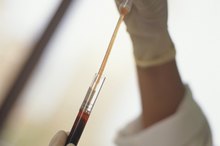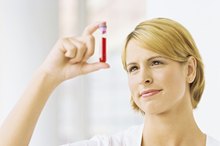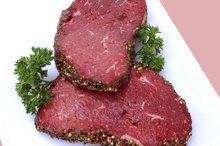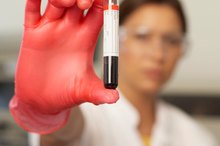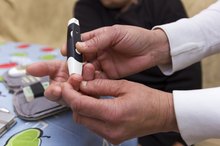Low Hemoglobin and Weight Loss
Oxygen travels through the blood on iron-containing proteins called hemoglobin. A low hemoglobin level indicates a decreased number of iron-containing proteins in the blood or a decreased red blood cell size. Decreased hemoglobin levels prevent your heart from delivering adequate oxygen to your body's tissues, muscles and organs. Include foods rich in vitamin B-12 and folate into your diet to prevent low hemoglobin levels and associated symptoms, such as weight loss.
Low Hemoglobin Causes
A low hemoglobin count may occur naturally or because of an illness. Low hemoglobin levels occur naturally in young women during menstruation and in pregnant women. Conditions such as cancer, cirrhosis, aplastic anemia, lead poisoning, Hodgkin’s disease and hypothyroidism cause a low hemoglobin count because your body produces fewer red blood cells than it does in a healthy state. Low hemoglobin counts also occur from diseases that destroy red blood cells faster than your body can make them, as occurs in porphyria, vasculitis, sickle cell anemia, thalassemia and splenomegaly. Heavy bleeding or a large loss of blood may also lead to temporary low levels of hemoglobin. Low hemoglobin levels that occur at the same time as weight loss often occur because of iron deficiency anemia.
- A low hemoglobin count may occur naturally or because of an illness.
Effects of Iron Deficiency Anemia
Causes of Microcytic Hypochromic Anemia
Learn More
Low hemoglobin levels may or may not affect the way your body functions. You may have low hemoglobin levels without experiencing any symptoms, but most people experience some form of dizziness, weakness, fatigue, headache or irritability, explains Dr. David Caruso, a family physician for Elk Regional Medical Center in St. Marys, Pennsylvania. Contact your health care provider if you experience symptoms of severely low hemoglobin levels, such as a faster than normal heart rate response to activity, shortness of breath, pale skin, pale gums or unexplained weight loss.
Testing
If your doctor suspects iron deficiency anemia, he may order a blood test known as a complete blood count, or CBC, to determine your hemoglobin count, hematocrit, number of red blood cells, number of white blood cells, number of platelets and the condition of your red blood cells, explains Caruso. Talk to your doctor about the foods you eat, medicines you take and any family history of anemia. Your doctor may order other tests to determine the cause of your anemia, such as a blood test to determine iron levels.
Treatment
What Are the Causes of Low Platelets & Low White Blood Cells?
Learn More
Treatment for anemia aims to return your hemoglobin levels to normal and correct the underlying cause of the anemia. Iron deficiency anemia requires dietary changes to prevent low hemoglobin levels and weight loss. Your doctor may prescribe a diet high in iron and iron supplements to return your hemoglobin levels to normal – between 13.8 and 17.2 gm/dL for males and between 12.1 and 15.1 gm/dL for females. Foods high in iron include iron-fortified breads and cereals, liver, lentils, dried fruits, lean red meats, tofu, fish, oysters, and green leafy vegetables. Foods high in vitamin C, such as oranges, strawberries and broccoli, help your body absorb iron. Foods high in caffeine or calcium, however, may hinder your body’s ability to absorb iron when consumed within 30 minutes of iron consumption, warns Caruso.
- Treatment for anemia aims to return your hemoglobin levels to normal and correct the underlying cause of the anemia.
- Foods high in caffeine or calcium, however, may hinder your body’s ability to absorb iron when consumed within 30 minutes of iron consumption, warns Caruso.
Related Articles
References
- National Heart Blood and Lung Institute: What Are the Signs and Symptoms of Iron-Deficiency Anemia?
- Dr. David Caruso, M.D.; Elk Regional Health Center; St. Marys, Pennsylvania
- Medline Plus: Hemoglobin
- University of Rochester Medical Center. Health Encyclopedia. What Are Red Blood Cells?
- Karakochuk CD, Hess SY, Moorthy D, et al. Measurement and interpretation of hemoglobin concentration in clinical and field settings: a narrative review. Ann N Y Acad Sci. 2019;1450(1):126-146. doi:10.1111/nyas.14003
- UptoDate. Patient education: Anemia caused by low iron in adults (Beyond the Basics). Updated April 9, 2019.
- U.S. National Library of Medicine. MedlinePlus. Hemoglobin Test. Updated July 31, 2020.
- U.S. National Library of Medicine. MedlinePlus. Thalassemia. Updated August 24, 2020.
- U.S. National Library of Medicine. MedlinePlus. RBC indices. Updated October 8, 2020.
Writer Bio
Kimberly Wonderly has a Bachelor of Science degree in exercise science and has worked as a personal trainer for six years. Wonderly has also taken many child development classes, while running a daycare out of her home for three years. She wrote for the "Rocket" at Slippery Rock University for two years while attending college.
